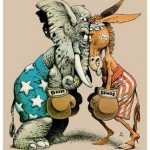New Study Adds to the Debate Surrounding Ideological Divides and the United States Supreme Court
 The New York Times published an article detailing the results of a new study regarding the career paths of former United States Supreme Court clerks. The study finds that “former clerks have started to take jobs that reflect the ideologies of the justices for whom they worked.” The data collected show a shift in the career paths of clerks hired from 1990 and on:
The New York Times published an article detailing the results of a new study regarding the career paths of former United States Supreme Court clerks. The study finds that “former clerks have started to take jobs that reflect the ideologies of the justices for whom they worked.” The data collected show a shift in the career paths of clerks hired from 1990 and on:
Until about 1990, the study shows, there was no particular correlation between a justice’s ideological leanings and what his or her clerks did with their lives.
Clerks from conservative chambers are now less likely to teach. If they do, they are more likely to join the faculties of conservative and religious law schools. Republican administrations are now much more likely to hire clerks from conservative chambers, and Democratic administrations from liberal ones. Even law firm hiring splits along ideological lines.
It is no secret that the justices have shown a greater propensity to hire clerks that share their ideological beliefs (as the article and previous studies explain). Yet this newest study, which focuses on life post-clerkship, has alarmed those already worried about the strong ideological splits on the Court. Says law professor William Nelson of NYU, “It’s cause for concern mainly because it’s a further piece of evidence of the polarization of the court.”

 Despite the increasingly audible calls for changes in policy, we should not lose sight of the extent and nature of imprisonment in the United States. As of 1975, only .01% of the population was imprisoned, but the percentage has grown every year since then and now stands at almost .05%. We as a nation have the dubious distinction of reporting the highest per capita imprisonment figure in the world. What’s more, American prisons are no longer geared to rehabilitating inmates. Instead of educating and training inmates, prisons for the most part simply warehouse them.
Despite the increasingly audible calls for changes in policy, we should not lose sight of the extent and nature of imprisonment in the United States. As of 1975, only .01% of the population was imprisoned, but the percentage has grown every year since then and now stands at almost .05%. We as a nation have the dubious distinction of reporting the highest per capita imprisonment figure in the world. What’s more, American prisons are no longer geared to rehabilitating inmates. Instead of educating and training inmates, prisons for the most part simply warehouse them.